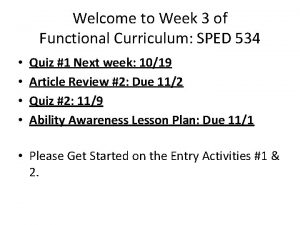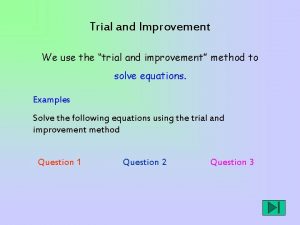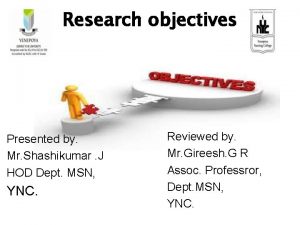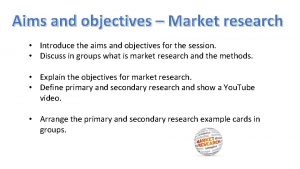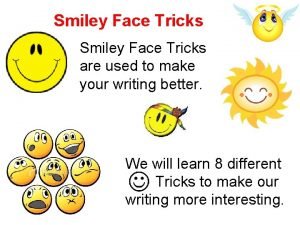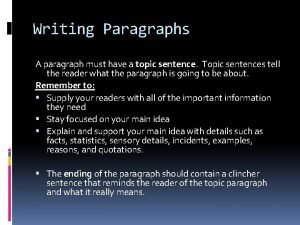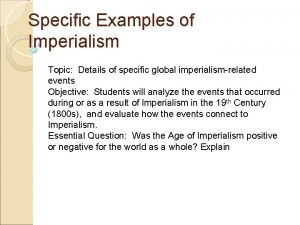ACT II Specific Examples from an ACT Trial

















- Slides: 17

ACT II: Specific Examples from an ACT Trial Jon Abramowitz, Laura Fabricant, & Ryan Jacoby Clinical Lunch Spring 2014

Overview � ACT principles � Our study on exposure therapy and ACT � Techniques to foster acceptance � Techniques to foster defusion � Techniques to pursue values � Discussion (applying ACT to other problems)

ACT Principles

I spend most of my time paying attention to what is happening in the present moment I willingly accept my thoughts and feelings even when I don’t like them 10 9 8 7 6 5 4 3 2 1 109 8 76 ACCEPTANCE SCALE 54 32 1 DEFUSION SCALE I see each of my thoughts as just one of many ways to think about things – what I do next is up to me 10 9 87 ATTENTION TO PRESENT SCALE 4 65 32 1 I am clear about what I choose to value in life I spend 10 89 most of my time 67 5 4 3 lost in thought 12 I constantly about the past or I don’t struggle future VALUES know what with my IDENTIFICATION I want SCALE thoughts from life and feelings My thoughts tell I don‘t me how things manage to really are, and act on the determine what I Deep down, my things I care do next 12 34 thoughts and about 56 I work out what I 78 feelings are the 9 10 COMMITMENT need to do about the real me & TAKING things I care about, ACTION 1 and SCALE 2 I see it through 3 SELF AS 4 OBSERVER 5 6 SCALE 7 8 9 10 My thoughts and feelings come and go, but deep down the real me doesn’t change

Our study: Exposure + ACT

Our Study � How � Our � An did we get interested in ACT? study ACT perspective on OCD: 3 parts � Exposure from an ACT framework � Similarities and differences (SUDS vs. willingness) � Exposure therapy to facilitate the ACT processes

ACT Techniques

Acceptance � Willingness � Examples to experience internal events from OCD patients � Metaphors and techniques � “Jerk at the door” � Chessboard � Exposure � Habituation vs. fear tolerance

Defusion � Distancing and disconnecting from thoughts � Seeing thoughts and feelings for what they are, not what they say they are � Examples from OCD patients � Metaphors � Milk, and techniques Milk, Milk � Passengers on the bus � Imaginal exposure

Passengers on the Bus Metaphor � You’re the driver and the passengers are your OCD related thoughts, feelings, physiological sensations, etc. � The passengers try to direct where the bus goes � They are loud and bossy about what you do � They quiet down when you do what they want � If you drive the bus where you want to go, what will happen? � You can allow them to shout and keep your attention focused on where you want to go

Values � Choosing what direction one wants life to take (not letting OCD choose the direction life goes) � Examples from OCD patients � Metaphors and techniques � Bull's-eye � Moving through a swamp � Exposure

� What do you value? � What do you want your life to be about? � What do each of these categories mean to you? � In what ways has OCD been getting in the way of living life in the direction of your values?

Moving through a swamp � Swamp = OCD-related inner experiences and triggers � Exposure = learning how to handle whatever comes up while still moving forward through swamp � Willingness to go into the swamp without resisting (avoiding or using compulsive rituals) � Why are we doing this? � Getting dirty and muddy but for a purpose � Not wallowing in the swamp � Things you value are on the other side of the swamp (only way is through it!)

Exposures and values � Emotional moves vs. values moves � Motivation � Anxiety reduction is not an explicit goal � Successful outcome = you doing something important to you despite having anxiety

Discussion

Discussion � How could we apply these techniques to other problems? � Similarities � Questions? and differences with otherapies?

Thank you!
 Specific gravity to specific volume
Specific gravity to specific volume Pharmaceutical application of specific gravity
Pharmaceutical application of specific gravity Behavioral objectives
Behavioral objectives Trial and improvement examples
Trial and improvement examples Errors affecting trial balance
Errors affecting trial balance Examples of discrete trial teaching
Examples of discrete trial teaching Overgeneralization aba
Overgeneralization aba Errors revealed by trial balance
Errors revealed by trial balance Macbeth act 2 summary
Macbeth act 2 summary Specific aims research proposal example
Specific aims research proposal example General objectives research
General objectives research Research objective definition
Research objective definition Site:slidetodoc.com
Site:slidetodoc.com Specific ordinary item examples
Specific ordinary item examples Examples of generic goals and product-specific goals
Examples of generic goals and product-specific goals Smiley face tricks examples
Smiley face tricks examples Specific details in writing examples
Specific details in writing examples Sensory details paragraph examples
Sensory details paragraph examples


